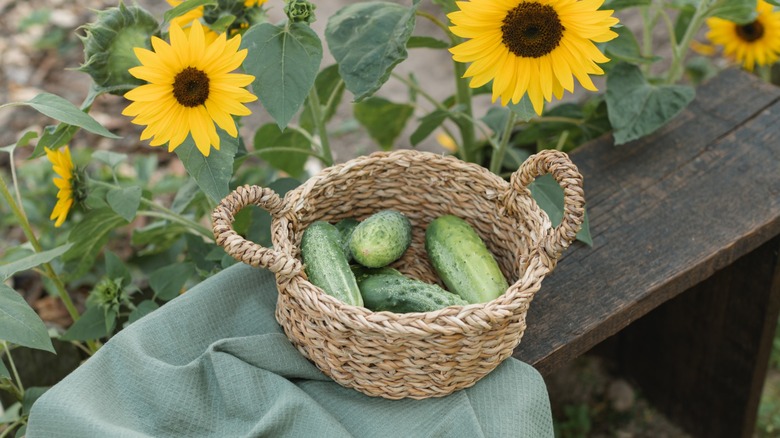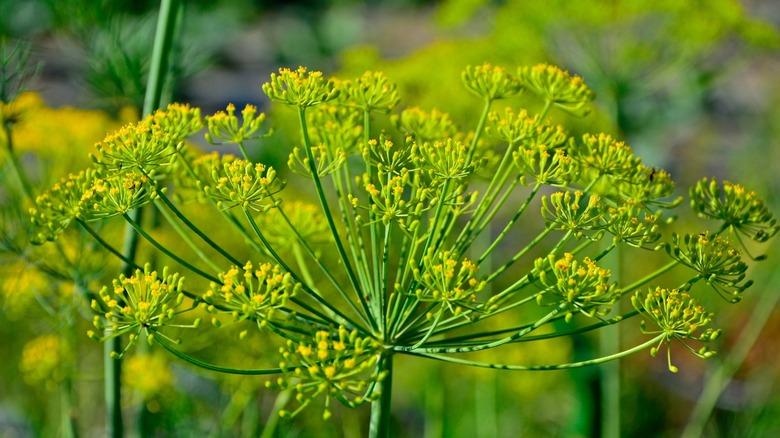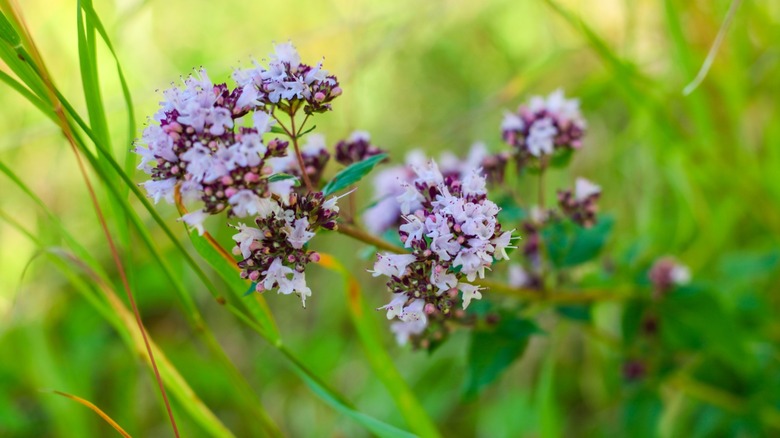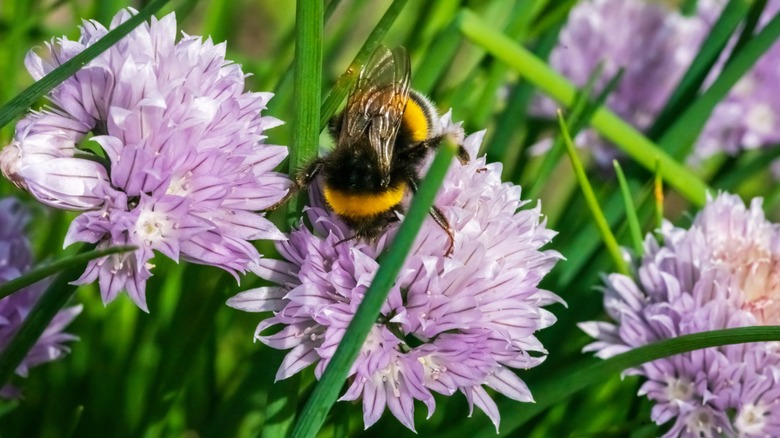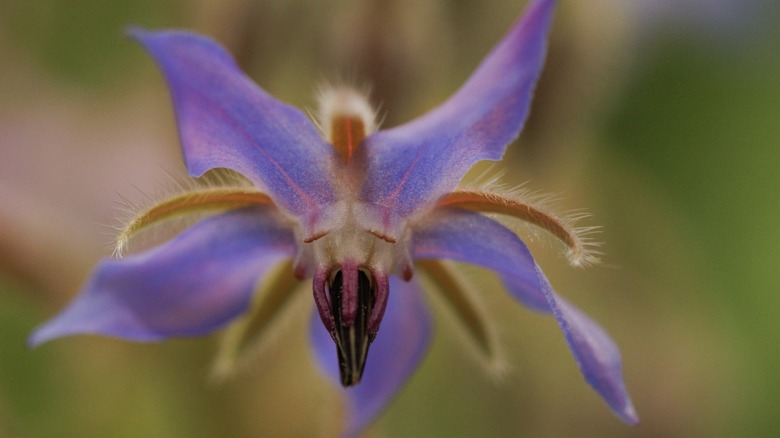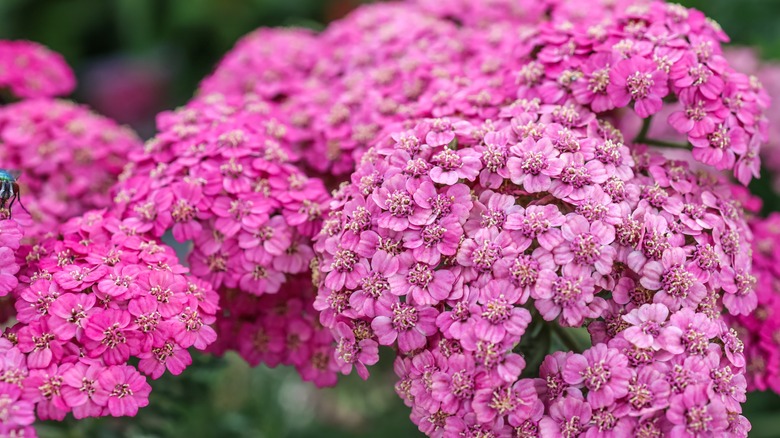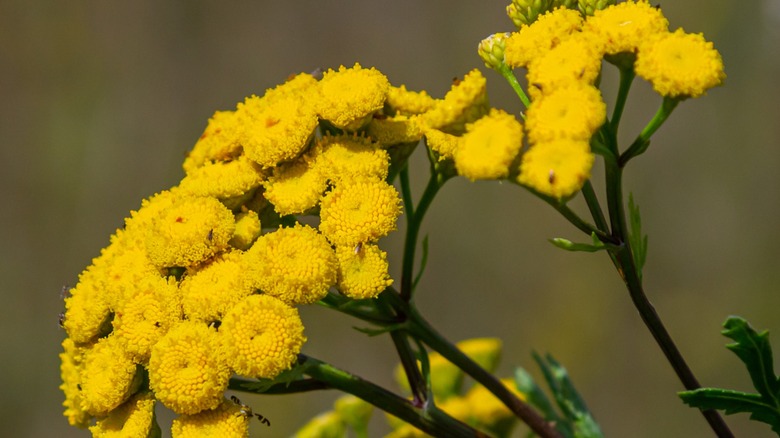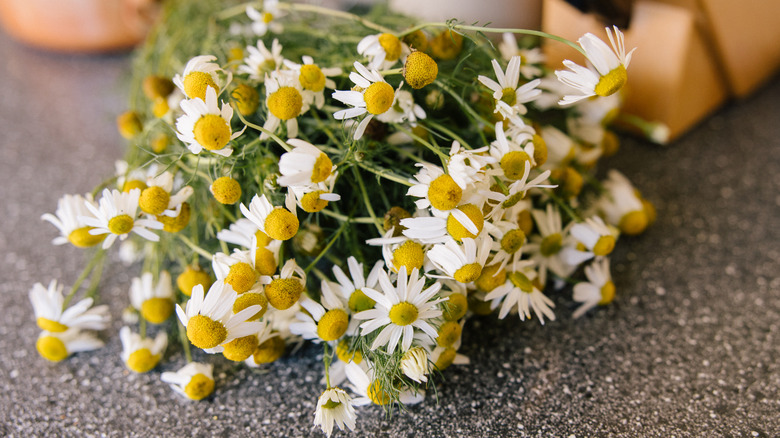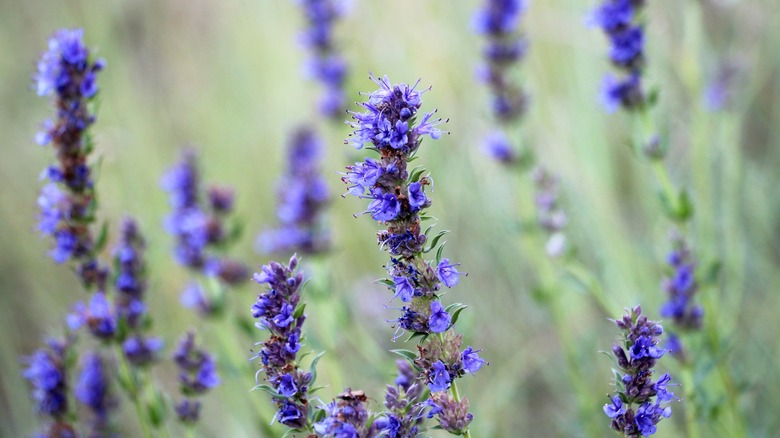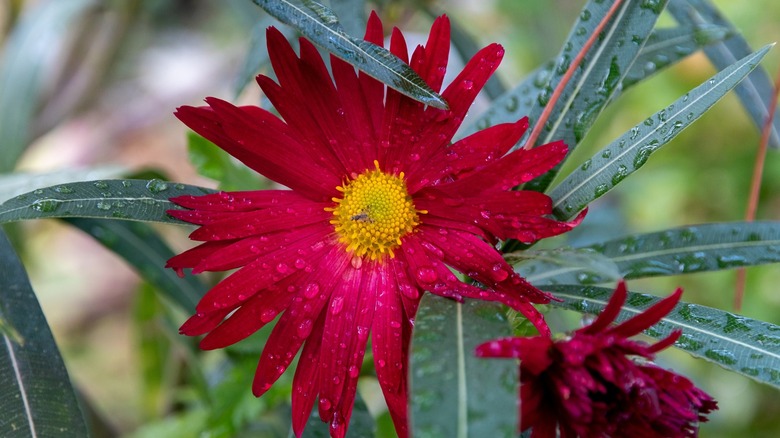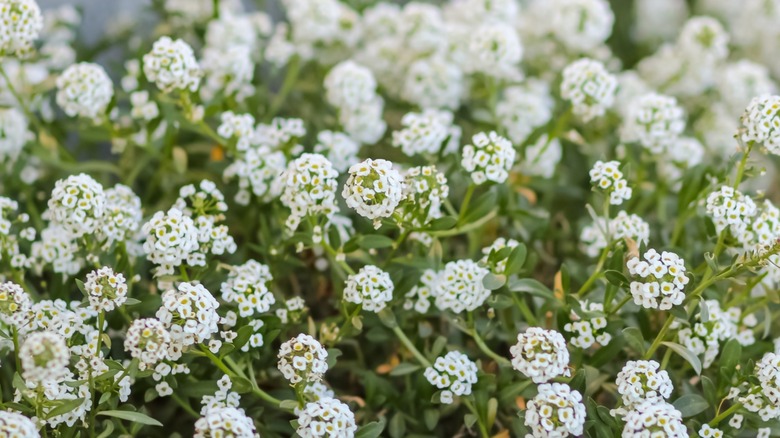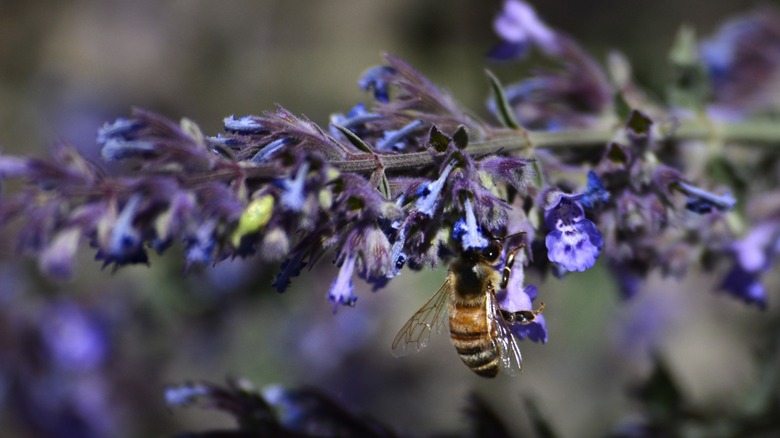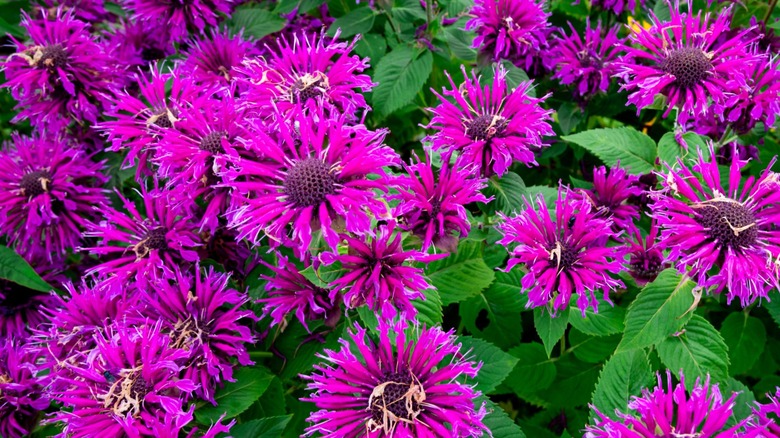15 Flowering Companion Plants That Can Ward Off Pests From Garden Cucumbers
Cucumber plants are fairly vulnerable to a wide variety of garden pests. And in order to protect your harvests, you can explore two options. The first is to reach for chemical pesticides at the first sign of trouble. But even that has its own side effects. However, there's a second, more natural, and frankly more beautiful way to protect your plants, and it starts with what you grow around them.
Companion planting is an old gardener's trick that involves pairing certain plants together because they thrive in each other's company. For cucumbers, surrounding them with specific flowering plants can create a natural defense system that works on multiple levels. Some flowers emit scents or compounds that repel common pests. Others attract helpful insects, such as ladybugs and parasitic wasps. These natural predators feed on the pests that try to harm your cucumbers. Sometimes, they serve as decoys, drawing the pests to themselves before they reach your cucumbers. But to see results from companion planting, you have to do it right.
That's why we've put together a list of flowering companions that can protect your cucumbers and also add vibrant color to your garden. With the right combinations, you'll rely less on synthetic pesticides and more on nature's own solutions. This way, you'll essentially be creating a pollinator garden that's beautiful and bountiful.
Sunflower
Sunflowers (Helianthus annuus) and cucumbers make a great pair in any garden. For starters, sunflower heads are magnets for pollinators, which cucumbers need to produce healthy fruit. These pollinators, like ladybugs, for instance, will in turn feast on notorious cucumber pests like aphids.
Their tall stalks also serve as a natural trellis, giving vining cucumbers extra support to climb and grow into a straighter form. And as they tower above the cucumber bed, sunflowers help provide partial shade from the sun, which in turn keeps moisture from evaporating too quickly from the soil.
Nasturtiums
Nasturtiums (Tropaeolum) are one of the best companion plants for cucumbers. These bright and versatile flowers, also called trap crops, are irresistible to aphids, cucumber beetles, and whiteflies. By planting them a short distance from your cucumber patch, you're creating a natural diversion that gives your cucumbers a better chance to thrive.
While they fight off harmful pests, their dense foliage acts as a living mulch, suppressing weeds and retaining soil moisture. And when it's time to harvest some cucumbers, you can also pluck some non-infested nasturtium leaves and flowers to add some spice to your salad or soup.
Dill
Dill (Anethum graveolens) is actually one of the top 3 companion plants garden experts recommend for cucumbers. Its flowers help attract both pollinators and beneficial insects. And below the surface, the roots deposit natural compounds into the soil to help fight off any pests and diseases that are burrowed deep.
While dill prefers slightly drier conditions than cucumbers, you can manage the situation by setting up an efficient irrigation system for your garden. And the best part about dill is that after helping your cucumber thrive in the garden, it still pairs perfectly with it in the kitchen.
Oregano
There are several benefits to growing oregano (Origanum vulgare). That's why it's not much of a surprise that it's part of the essential herbs Martha Stewart plants in her own garden. Beyond its benefits in the kitchen, oregano produces aromatic oils rich in compounds like carvacrol and thymol, which have been scientifically tested to repel pests like aphids, mosquitoes, and caterpillars that might want to chomp away on your cucumber plants. It's also low maintenance. Once you've planted, it mostly takes care of itself. Just give it the occasional trim so it doesn't creep into your cucumber patch.
Chives
Chives (Allium schoenoprasum) may be popular for cooking, but they also make great companions for cucumbers. The same onion-like scent that gives them their bold flavor in meals also works in the garden to drive away pests like aphids and even larger animals like rabbits and deer. Their beautiful purple pom-pom flowers attract pollinators, such as bees, which improve fruit production on nearby cucumber plants.
Chives are also easy to grow. They don't compete aggressively for space, sunlight, or nutrients. Just plant some along the edges of your cucumber bed, and their strong scent will create a protective perimeter.
Marigolds
Recent scientific research now backs up what many gardeners have already suspected: Marigolds (Tagetes spp.) help protect nearby plants. That's because these flowers naturally produce thiophenes — sulfur-rich compounds released from their roots and leaves — that are toxic to certain pests, especially root-knot nematodes lurking in the soil.
Their strong, distinctive scent also helps mask the scent of your cucumber plants, confusing pests, and making it harder for them to find and invade your cucumber patch. Marigolds also attract beneficial insects like ladybugs and parasitic wasps that feed on garden pests, and their flowers invite pollinators like bees and butterflies.
Borage
There's a lot to love about Borage (Borago officinalis). They have beautiful star-shaped blue blooms, edible leaves and flowers, and can thrive with little maintenance. They rarely get affected by diseases and are attractive to pollinators, especially bumblebees. The more pollinators around your cucumber, the better your plants will fruit.
In addition, they do some pest control with hornworms and aphids. Plus, their deep taproots pull up minerals like calcium and potassium from the subsoil, nourishing your garden bed as their leaves decompose. So, with borage, you get healthier cucumbers and soil that gets better with time.
Yarrow
The interesting thing about yarrow (Achillea millefolium) is that its name traces back to the Greek warrior Achilles. Legend has it that Achilles used the plant to treat his soldiers' wounds during the Trojan War. Today, science confirms that yarrow leaves indeed contain powerful antioxidants and even anticancer properties.
So, if Achilles had a cucumber garden today, he'd probably plant yarrows beside it. That's because it attracts helpful insects, like parasitic wasps, ladybugs, and hoverflies, which are natural predators of aphids and other common cucumber pests. Yarrow also brings in honeybees, which can improve pollination and boost your harvest.
Tansy
Tansy (Tanacetum vulgare) is another flowering plant with ancient history. The Greeks once called it the "leaf of immortality," believing it could expel intestinal worms and even preserve the body after death. Over time, it made its way into kitchens and apothecaries as both a medicinal and culinary herb.
Today, tansy helps gardeners drive away ants, squash bugs, and cucumber beetles. So, having tansy near cucumbers can help keep your patch healthy. Note: Tansy is toxic to many animals, so plant with care if you have pets or livestock roaming your yard.
Chamomile
Chamomile (Matricaria chamomilla) is most popular as a calming herbal tea. While drinking some helps soothe your nerves, using some chamomile tea in your garden can also help suppress the likelihood of your plants getting infested. It contains antibacterial and antifungal properties that make it an effective and safer pesticide substitute.
Even as a companion plant, chamomile is useful in protecting nearby plants from harmful insects and fungal infections. So, with some chamomile in your orchard, your cucumber plants stand a better chance against diseases like mildew.
Hyssop
Hyssop (Hyssopus officinalis) is another flowering plant that is popularly used to make medicinal tea. And, as a companion to your cucumbers, its strong, minty scent helps keep pests like aphids away. At the same time, its violet-blue blooms are great for drawing in pollinators.
However, that same strong scent may interfere with the flavor of your cucumber, so you'll want to place hyssop along the borders of your cucumber patch rather than planting directly beside the vines. That way, you can create a protective barrier without yielding bitter cucumbers.
Chrysanthemum
Chrysanthemums (Chrysanthemum spp.) contain high concentrations of pyrethrins, a powerful natural compound that disrupts the nervous systems of common cucumber pests. Once it comes into contact with the insects, they become paralyzed and are unable to complete their mission of ravaging your cucumbers. Depending on the dose, they could actually die within minutes.
These flowers are so effective that they eventually inspired scientists to develop the organic pyrethrum sprays we use today. And you can even make your own DIY pest spray by soaking dried chrysanthemum flowers in water with a bit of soap and oil.
Sweet alyssum
Sweet alyssum (Lobularia maritima) might look delicate, but it's surprisingly effective at pest control and can help you grow the best cucumbers. The sweet, honey-like scent it radiates, plus its dense flowers, attracts insects like parasitic wasps and ladybeetles, which are natural predators that love to chomp on cucumber pests.
It spreads low to the ground, essentially working as a living mulch while keeping weeds in check. Because it's an annual plant, you can have it around all season to protect your cucumbers, and since it self-seeds, it can actually remain in your garden for years.
Catnip
Catnip (Nepeta cataria) might be famous for sending cats into a frenzy, but in your cucumber patch, its natural oils release a strong scent that repels some of the usual suspects when it comes to cucumber damage.
At the same time, catnip flowers help attract both pollinators and beneficial bugs that help hunt the pests you're trying to get rid of. With catnip, though, you have to be careful. It spreads quickly, so it's best to grow it in containers and trim it regularly. However, when maintained properly, this plant will also send mice running from your garden.
Bee balm
By planting bee balm (Monarda) in your orchard, you'll be getting better pollination, natural pest control, and a colorful orchard all in one. Its vibrant, pom-pom-like blooms, which are usually red, purple, or pink, are irresistible to bees, butterflies, and hummingbirds. That's good news for cucumbers since they need pollination to produce healthy fruit.
It also has a pungent, minty scent that pests like cucumber beetles, squash bugs, and even rabbits and deer find disgusting. So, it helps mask the smell of your cucumbers and reduces the chance of an attack.

